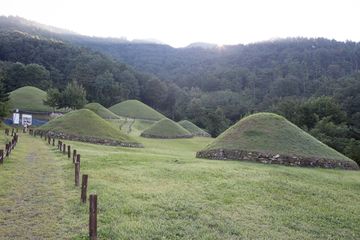창녕 교동과 송현동 고분군(가야고분군)
| 창녕 교동과 송현동 고분군 Ancient Tombs in Gyo-dong and Songhyeon-dong, Changnyeong |
|
 창녕 교동과 송현동 고분군, 국가문화유산포털, 문화재청. |
|
| 대표명칭 | 창녕 교동과 송현동 고분군 |
|---|---|
| 영문명칭 | Ancient Tombs in Gyo-dong and Songhyeon-dong, Changnyeong |
| 한자 | 昌寧 校洞과 松峴洞 古墳群 |
| 주소 | 경상남도 창녕군 창녕읍 교리 129 등 |
| 지정(등록) 종목 | 사적 제514호 |
| 지정(등록)일 | 2011년 7월 28일 |
| 분류 | 유적건조물/무덤/무덤/고분군 |
| 수량/면적 | 460,011㎡ |
| 웹사이트 | 창녕 교동과 송현동 고분군, 국가문화유산포털, 문화재청. |
|
|
|
해설문
국문
교동과 송현동고분군은 창녕분지의 평야지대를 기반으로 5세기부터 가야 동부지역의 유력한 세력으로 성장한 비화가야 왕과 지배층의 무덤들이다. 화왕산의 서쪽 자락인 교동과 송현동에 위치하며 5세기부터 6세기까지 조성된 서쪽 구릉과 6세기 전반에 조성된 동쪽 사면부로 구분된다.
교동과 송현동고분군의 석곽묘는 가야식 석곽묘에 석실묘의 출입시설을 결합한 독특한 형식이다. 부곽이나 별도의 순장곽을 만들지 않고 석곽 내부를 3분할하여 중앙에 관을 놓고 양쪽 공간에 각종 물품과 순장자를 묻었다.
교동과 송현동고분군에는 창녕지역의 특징인 짙은 흑색에 대각형태의 꼭지가 달린 뚜껑 있는 굽다리접시를 부장하여 비화가야의 영역범위를 알려준다. 또한 고분에 부장된 각종 위세품과 교역품은 비화가야의 세력과 대외관계를 보여준다. 신라의 제작기술이 드러나는 금공품, 마구류 등과 백제에서 들여온 것으로 보이는 큰칼, 투구, 일본산 녹나무로 만든 목관 등을 통해서 신라, 백제, 일본과의 교류양상을 알 수 있다.
교동과 송현동고분군은 가야와 신라의 접경지에 위치했던 비화가야의 문화적 특성을 잘 드러내며, 가야가 신라에 병합되어 가는 과정을 보여주는 대표 고분군이다.
영문
Ancient Tombs in Gyo-dong and Songhyeon-dong, Changnyeong
These tombs are presumed to have been built between the 5th and 6th centuries for the rulers of Bihwa Gaya, one of the members of the Gaya confederacy (42-562). Bihwa Gaya was located in the northeastern area of the Gaya confederacy, which is today’s Changnyeong area, and grew into a powerful polity in the 5th century. It is said to have been annexed by the Silla kingdom (57 BCE-935 CE) around 555.
Since the 1910s, a number of excavations and surveys have been conducted, revealing that there are approximately 320 tombs scattered throughout this area. Most of the tombs are stone-lined tombs, and 101 of the tombs have intact tomb mounds. In general, the tombs were built without any auxiliary chamber for burial goods. The stone-lined pit was divided into three sections instead, with the coffin being placed in the center with burial goods and areas for the bodies of human sacrifices on either side.
Artifacts discovered from these tombs include blackish mounted dishes with lids, gilt-bronze crowns, farming tools, and armor. Also, other artifacts attest to the cultural exchange between Bihwa Gaya and its neighboring kingdoms, such as metal craft items and horse harnesses produced with Silla-style techniques, large swords and helmets presumably imported from the Baekje kingdom (18 BCE-660 CE), and coffins carved from the trunk of camphor tree from Japan. Some artifacts are similar to those from Gyeongju, the capital of the Silla kingdom. This shows that the local elites’ cultural orientation at the time was shifting toward Silla.
영문 해설 내용
이 고분군은 가야연맹의 한 나라인 비화가야의 왕과 지배층의 무덤으로, 5세기부터 6세기까지 조성된 것으로 추정된다. 비화가야는 5세기부터 가야 북동부 지역(지금의 창녕 지역)의 유력한 세력으로 성장하였으며, 555년경 신라에 포함된 것으로 알려져 있다.
1910년대부터 현재까지 지속적인 조사 및 발굴을 통해 총 320여 기의 무덤이 분포하고 있는 것으로 확인되었다. 대부분의 무덤은 석곽묘이며, 봉토가 남아있는 것은 101기이다. 별도의 부곽을 만들지 않고 석곽 내부를 3분할하여 중앙에 관을 놓고 양쪽 공간에 각종 물품과 순장자를 묻었다.
이곳에서 발견된 여러 유물 중에는 짙은 흑색의 뚜껑 있는 굽다리접시, 금동관, 농공구류, 무기류 등이 있다. 또한 신라의 제작 기술이 사용된 금속 공예품 및 마구류와 백제에서 들여온 것으로 보이는 큰칼, 투구, 일본산 녹나무로 만든 목관 등을 통해 당시 비화가야와 신라, 백제, 일본의 교류 양상을 알 수 있다. 그리고 일부 유물은 당시 신라의 수도였던 경주 지역에서 출토되는 것과 그 형태가 흡사하여, 이 지역의 지배계층이 가야에서 신라로 변화하는 과정을 살필 수 있다.